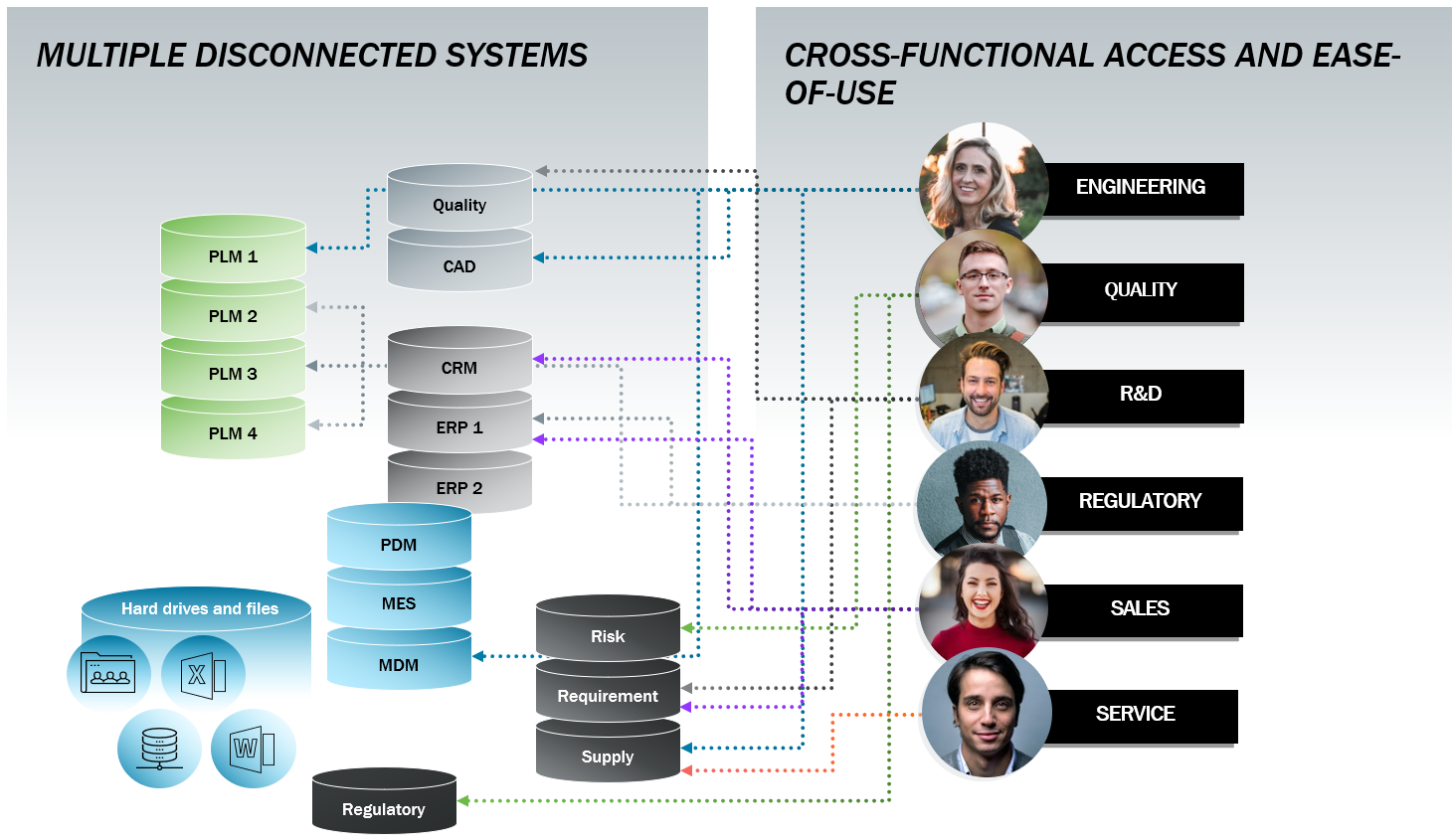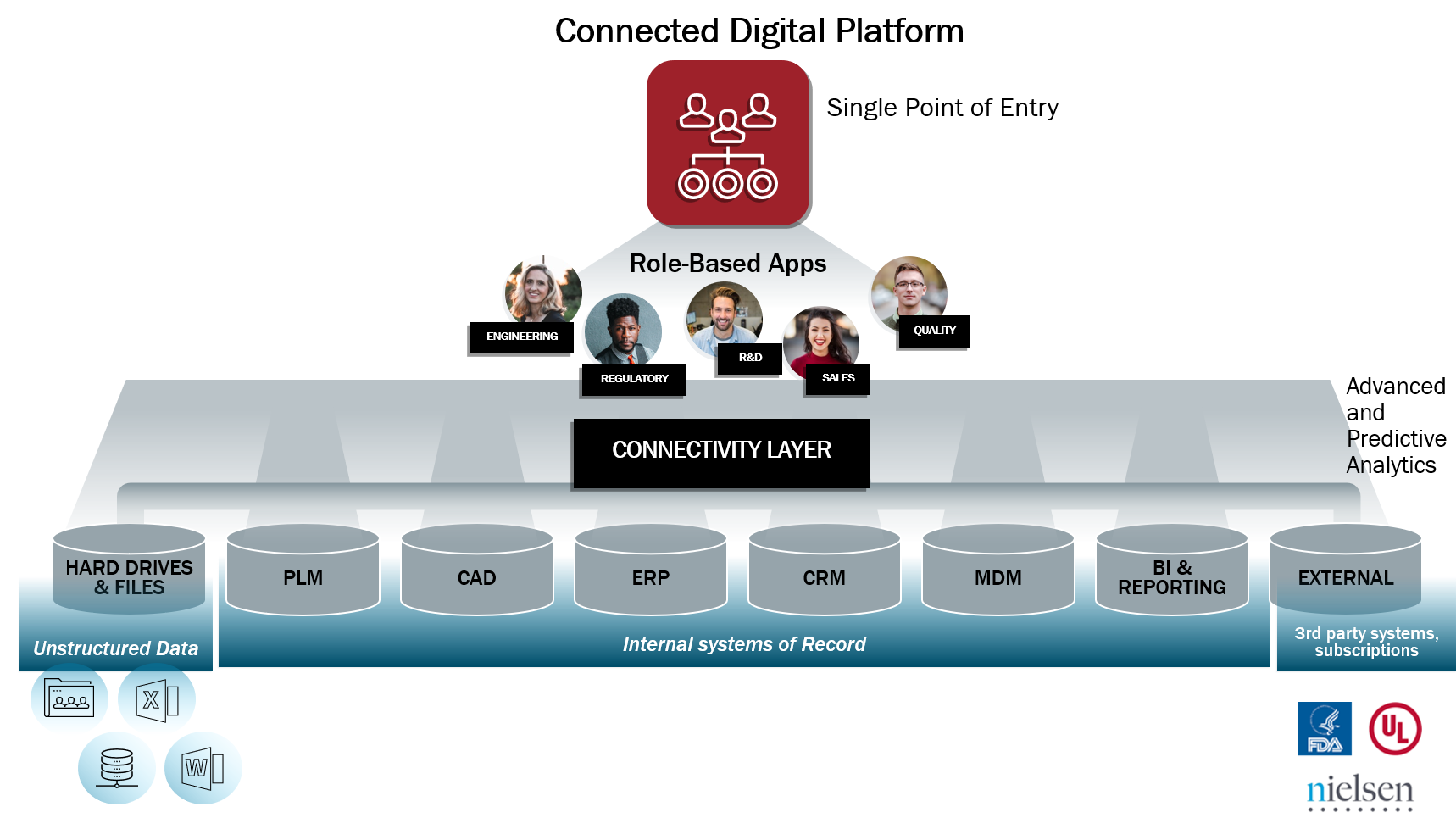The Value of Business Apps: Simplify Collaboration & Reduce Complexity for an Integrated Enterprise
What would we do without apps? Applications or ‘apps’ are indispensable in our everyday lives. It all started with the first iPhone app in 2007, and by 2013 there were over 1 million apps available and in use. Today, it is hard to imagine our personal lives without the convenience, simplicity, and efficiency of apps that help us quickly pay bills, connect with friends, or catch up on the latest news.
But where are apps in our professional lives? While apps have significantly improved day-to-day productivity in our personal lives, this has not translated in the same way to our professional lives. There are some limited enterprise software apps, but frequent work tasks still require multiple clicks, arduous steps, and numerous logins across different systems.
The Disconnected Web We Weave
More than ever, bringing products to market in the 21st century requires a cohesive and connected cross-functional enterprise. Unfortunately, global expansion at scale, increased regulatory and quality requirements, and the new demands of connected products have thrust more complexity on already ill-equipped organizations.
The reality behind the scenes at many companies (including successful ones) is a level of dysfunction and chronic inefficiency between the different functions, divisions, and regions working together to develop and commercialize products. The effort required to win in the market has always been difficult, but the current environment creates functional silos and an untenable dynamic of complexity. The result is at best intra-company bottlenecks and frustration, and at worst a fundamental competitive disadvantage. This inefficiency is the root cause of myopic decisions, slower time to market, missed ship dates, cost overruns, reworks, product non-conformance, and even recalls.
Much of the inefficiency and dysfunction found in global organizations today lies with the IT systems in use across the enterprise. Years of unsustainable organic and inorganic growth has outpaced IT’s ability to maintain existing systems, let alone respond to new requirements and user demands. The result is a disconnected web of core, legacy, SaaS, on-premise, and functional point systems. The exact systems and numbers may change, but the story is the same everywhere – siloed systems, processes, and people adding unnecessary complexity and crippling the ability to effectively execute core integrated processes.

The internal ecosystem of cross-functional teams, divisions and regions all need to balance speed against quality, regulatory, and cost expectations, yet the tools they have are insufficient. A mechanical engineer ‘hires’ a tool to accomplish a specific job-to-be-done, and this is quite different from the need of a supply chain analyst. Yet both need access to much of the same data and both are challenged to navigate a corporate labyrinth of unfamiliar systems or must request and then wait for the needed data. Bottlenecks and inefficiencies are to be expected, but many organizations operate with archaic difficulty, which is no longer justified given the technology available today.
Business Apps and the Connected Digital Platform
The emergence of low-code application platforms (LCAPs) changes this model and makes apps relevant in the business world by significantly simplifying development effort and improving the user experience. Much like Apple provided open software development kits to pave the way for specialized functionality and broad usage, LCAPs enable organizations to rapidly develop their own apps or enhance existing product lifecycle management (PLM) solution capabilities without deep and costly technical expertise.
Low-code development combined with solutions for integration, data management, workflow, reporting, and analytics enables a holistic connected digital platform that simplifies daily task execution across the enterprise while providing rich and efficient user experiences. Connected digital platforms using either a fully enabled LCAP or a stacked solution architecture can deliver business apps that offer the same benefits as those that have transformed our personal lives. Just like with iPhone or Android, business apps make various jobs-to-be-done easier by providing quick access, a simple interface, and targeted functionality by user role.
Digital technologies like IoT that enable the connected digital platform are traditionally viewed through an ‘art of the possible’ lens. Today’s powerful, flexible, and scalable disruptive technologies provide a new frontier for organizations to explore the seemingly endless internal and external connectivity and advanced analytics opportunities. However, while advanced use cases can be realized, there is also a real opportunity to address fundamental, day-to-day tasks and systemic organizational issues using an LCAP-enabled connected digital platform architecture.
The same digital technology that receives rightful recognition in delivering bold, transformative programs should also be leveraged to deploy apps that simplify and solve the less glamourous – but still critical – underlying challenges that add complexity and inhibit organizational productivity.
Apps for Organizations
A connected digital platform enabled with apps offers significant productivity and efficiency opportunities for global enterprises that have multiple systems, numerous data sources, and a matrixed user base. The architecture displayed and described below solves the fundamental data access and visibility issue while providing an onramp for true cross-functional collaboration, simplification of the many interdependent enterprise processes, and a foundation for an advanced analytics capability.

Single Point of Entry
A core element of a connected digital platform is a single portal or URL for users from any function, business unit or region to quickly access and correlate product data from disparate systems. The ability to access multiple systems and sources through a single interface streamlines the many processes that require specific data inputs.
Users can also ‘self-serve’ the pieces of product information they need without the inefficiencies and delays that come with requesting it from their cross-functional colleagues. This simple but critical feature increases the time each team member spends on value-added work at all points along the digital thread for product development and commercialization. This in turn has a significant compound and ripple effect that improves everything from the time required to process a change request, to the ease of responding to customer and regulatory bodies, to a fundamental reduction in time from idea to market.
Connectivity Layer
With recent advances, digital and IoT technologies can now deliver on the promise of a truly open connectivity model. New solutions reliably offer flexible connectors that allow quick and inexpensive integrations to common commercial software systems of record, sources of unstructured data, and external 3rd party systems. Companies can use a connected digital platform architecture to aggregate the full universe of product information and establish a more complete and powerful base of data. With this in place, they can then take advantage of the advanced analytics and business intelligence functionality also available with many of these solutions.
Role-Based Apps & User Experience
Ultimately, despite the many technical capabilities of a connected digital platform, the adage ‘form follows function’ applies as always. A great technology architecture is only as useful as its ability to help users accomplish their jobs-to-be-done. To drive real value for the organization, connected digital platforms must complement system connectivity and data aggregation with elements that streamline and simplify the user experience.
A role- or task-based app experience should provide:
- A modern and intuitive user interface
- Role-based views and streamlined access to pertinent data
- Focused navigation and fewer clicks to complete individual tasks or processes
While there are many integration technologies available on the market that have improved the ease and cost of deploying a connectivity layer, there is a limited set that can reliably combine that with robust user experience features. When evaluating either a fully enabled standalone or stacked solution option, organizations should seek – at a minimum – a solution that is LCAP-enabled and that offers both standard system connectivity tools and user experience features. Building a solution architecture that extends that capability to advanced reporting and analytics will enable a fully connected digital platform.
Three Key Business App Functions
Connected digital platform solutions drive value across three basic app functions.
Federated Search
Individual access for self-guided advanced search, view, and extraction of complete product data and associated documents from multiple systems.
Dashboard & Reporting
Mashups aggregating cross-system, cross-functional, cross-BU, or cross-region data into a single view, chart, or impact report.
Role-Based Functions
A wide-ranging set of apps, targeted to common functions and roles to simplify frequent tasks including:
- Executing change requests and orders, workflow, approvals, notifications embedded within PLM or across systems
- Consolidating various data inputs, documents and forms for internal summary or external submission
- Streamlining and enabling core ISO processes including document and design control, part/BOM management, audits and product registration as well as a variety of integrated cross-functional processes such as portfolio reviews, SKU rationalization, regulatory submissions, and sales & operations planning
Leveraging Apps for System Consolidation and Integration
In large global organizations, disparate systems and complexity will remain to some extent, since companies continuously expand, merge, and evolve. Some level of specialized functional point systems is warranted when specific functionality is simply not possible with generalized software platforms.
However, with recent advances in connected digital platforms, it’s time to reexamine tradeoff decisions between consolidation vs. integration of systems. New open connectivity frameworks ease integration and allow for enterprise access regardless of source data model, which means organizations can change the way they think through their options and strike the appropriate balance.
For example, following years of consolidation and data migration efforts to bring disparate data together from various PDM, new product introduction, engineering, quality, regulatory, and supply chain systems, many organizations have taken steps towards a single, global enterprise PLM system. However, that process and effort is often lengthy, painful, and costly. System-to-system data mapping and migration is complex, underestimated, and time-consuming. Deployment sequences to each business unit or region may require multi-year roadmaps. While the vision and journey towards consolidation into a single PLM system remains incredibly advantageous, there’s a new option to consider that smooths the path and transitory roadmap.
Connected digital platforms with role-based apps can provide immediate relief and benefit to users in lieu of consolidations or as an interim solution during the process. From an end-user perspective, certain source data systems and inputs can remain as-is, just with better enterprise access and an improved user experience. The business maintains continuity and minimizes disruption, while the IT department simultaneously establishes a flexible architecture designed to manage existing complexity and positions the organization to easily scale for future system needs, changes, and disruptions.
Final Thoughts
Today’s work environment is fraught with complexity that is exacerbated by disparate and difficult-to-use systems, each containing relevant product data. This dynamic siloes organizations and prevents key stakeholders from easily accessing data, making holistic decisions, executing critical core processes, and completing daily jobs-to-be-done.
Even though the solution seems (and is) simple, a connected digital platform with role-based apps can reduce internal complexity, significantly increasing speed to market, improving quality and reducing cost. With the advanced digital technology readily available in the market today, connected apps are the quick win that deploys rapidly and inexpensively to make a huge impact.

